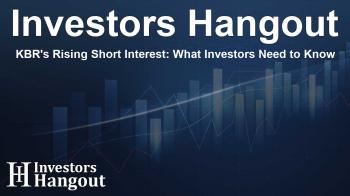KBR's Rising Short Interest: What Investors Need to Know

Understanding KBR's Rising Short Interest
KBR Inc (NYSE: KBR) has seen a notable increase in its short percent of float, which has risen by 10.41% since the last reporting period. Currently, the short interest stands at approximately 4.61 million shares sold short, equating to around 4.03% of its total shares available for trading. This significant development indicates that traders might need an average of 4.46 days to cover their short positions based on current trading volumes, a factor investors should consider.
Why Short Interest Holds Significance
Short interest refers to shares that have been sold short but remain uncovered. Essentially, when a trader engages in short selling, they sell shares they do not own, betting on a price decrease. Successful short selling relies on a decline in stock prices, leading to profits, while an increase results in losses.
Monitoring short interest is crucial, as it provides insights into market sentiment regarding stock performance. An uptick in short interest often reflects bearish investor sentiment, while a decline signals bullish perspectives on the stock's potential.
Short Interest Graph Analysis
The recent data and trends regarding KBR’s short interest highlight a growing number of shares being shorted, suggesting increased caution among investors. While this uptick does not directly indicate an impending decline in stock value, it is a clear sign that more traders are engaging in short-sell strategies. Investors should be mindful of these market fluctuations and their potential implications.
Comparative Analysis of KBR's Short Interest
To gauge KBR's standing in the market, it’s essential to compare its short interest against competitors within the industry. Analysts frequently conduct peer comparisons, utilizing criteria such as industry, company size, and financial structure to determine relative performance.
Recent market analysis indicates that KBR’s peer group averages a short interest of just 5.38%, positioning KBR with lower short interest relative to many of its competitors. This information is vital for investors seeking to assess the viability of KBR’s market position.
Implications of Increasing Short Interest
Interestingly, a rise in short interest may not always predict negative outcomes for a stock. In many cases, this can signal the potential for a short squeeze, where a surge in buying causes a rapid price increase, thereby benefiting long-term investors. Understanding these dynamics can aid investors in making more informed decisions regarding KBR's stock.
Conclusion: Navigating Investment Strategies
Investors should keep a close eye on the changing dynamics of KBR's stock as recorded short interest patterns evolve. The current increase in short interest reflects shifting market sentiment, hence serving as a crucial indicator for potential future movements in the stock price. By paying attention to trends in short selling, investors can better navigate their investment strategies in relation to KBR Inc (NYSE: KBR).
Frequently Asked Questions
What is short interest and why is it important?
Short interest indicates the number of shares sold short that have not been covered. It's important as it reflects market sentiment toward a stock, showing whether investors are bullish or bearish.
How does KBR's short interest compare to its peers?
KBR's average short interest is lower than its peers, which reflects a more bullish perspective compared to similar companies in the industry.
What does an increase in short interest signify?
An increasing short interest can indicate that investors are becoming more bearish on the stock, suggesting caution in investment decisions.
What might happen if short interest rises significantly?
Significant short interest increases can lead to a short squeeze, in which rapid price rises catch short sellers off guard, potentially benefiting long holders of the stock.
How often should investors check short interest?
Investors should monitor short interest periodically, especially before important earnings reports or significant market events, as it can signal changes in sentiment and potential volatility.
About The Author
Contact Dylan Bailey privately here. Or send an email with ATTN: Dylan Bailey as the subject to contact@investorshangout.com.
About Investors Hangout
Investors Hangout is a leading online stock forum for financial discussion and learning, offering a wide range of free tools and resources. It draws in traders of all levels, who exchange market knowledge, investigate trading tactics, and keep an eye on industry developments in real time. Featuring financial articles, stock message boards, quotes, charts, company profiles, and live news updates. Through cooperative learning and a wealth of informational resources, it helps users from novices creating their first portfolios to experts honing their techniques. Join Investors Hangout today: https://investorshangout.com/
The content of this article is based on factual, publicly available information and does not represent legal, financial, or investment advice. Investors Hangout does not offer financial advice, and the author is not a licensed financial advisor. Consult a qualified advisor before making any financial or investment decisions based on this article. This article should not be considered advice to purchase, sell, or hold any securities or other investments. If any of the material provided here is inaccurate, please contact us for corrections.

